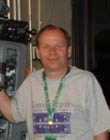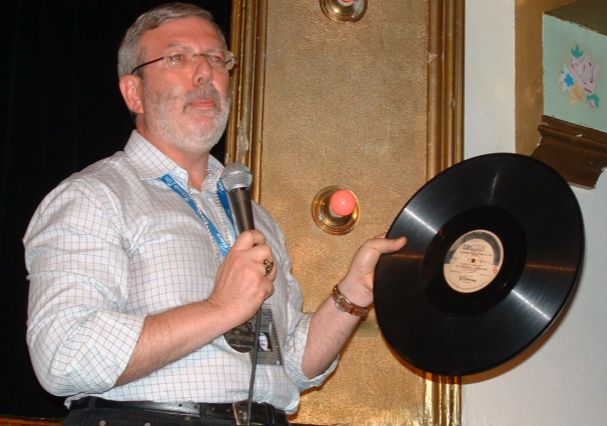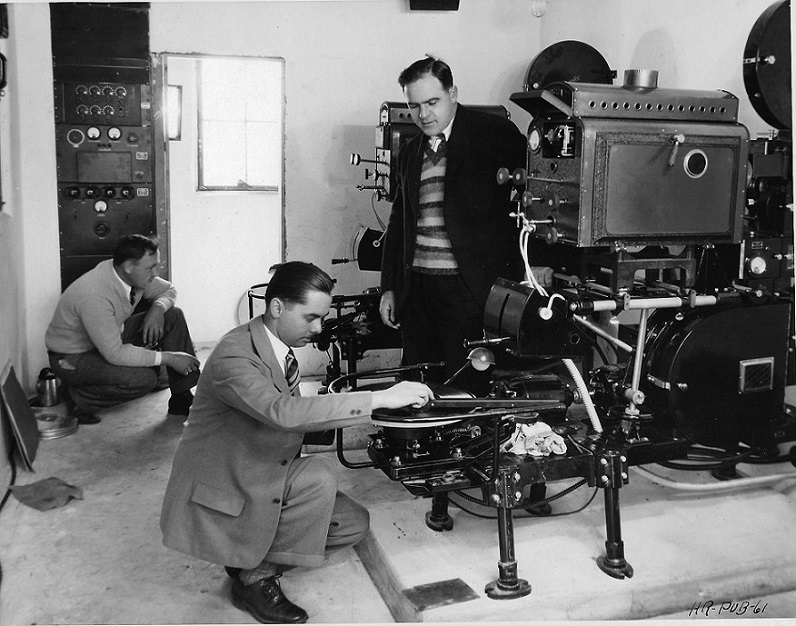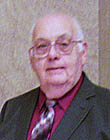|
|
This topic comprises 2 pages: 1 2
|
|
Author
|
Topic: The Jazz Singer (1927 version).
|
|
|
|
|
Leo Enticknap
Film God

Posts: 7474
From: Loma Linda, CA
Registered: Jul 2000
|
 posted 07-26-2015 07:25 PM
posted 07-26-2015 07:25 PM





![[Eek!]](eek.gif)
Fingerprint grease all over the groove ... all it would take is for his hand to slip ... that photo could be subtitled "How not to handle a record." I'm probably being OCD and that disc is just one of a dozen surviving copies, and not the one in the best condition, but even then if I were an archivist for the institution that preserved this record, I would be mightily p!ssed at that photo entering the public domain.
Also worth noting that there were some important differences in Vitaphone discs from consumer ones which made them sound a lot better. The groove pitch was wider, and they were made from a much softer mix (more shellac, less abrasive filler). The soft steel needles were only supposed to be used for one side before replacement (although there are numerous reports in the trade press of less reputable theaters using them two or three times), and the records had a designed lifetime of only 24 passes.
As SOD was winding down, Warners/Vitaphone tried to cut costs by subcontracting their record pressing to RCA Victor in 1931, who reduced the size to 12", reduced the groove pitch and used an early vinyl compound as the substrate. They didn't sound anything like as good, with a worse s/n and more surface noise. The final US SOD theater installations were done with a contract that guaranteed record availability until 1934, so Warners had to find a way to keep supplying the small number of screens that stuck it out until the end (not a dissimilar situation to the remaining 35mm installations now).
So when they're remastered carefully and sensitively, Vitaphone titles can sound seriously good.
| IP: Logged
|
|
Jim Cassedy
Phenomenal Film Handler

Posts: 1661
From: San Francisco, CA
Registered: Dec 2006
|
 posted 07-26-2015 08:53 PM
posted 07-26-2015 08:53 PM




Leo- Relax- - take a deep breath:
That's one of my "show & tell" disks - the surface is not in the best shape,
and it actually has a crack in it. It's the "pass around" disk used for
show & tell, such as you see here. I never would have let them treat a
'good' disk this way, and I'm pretty sure Mr Maltin, who has a great
knowledge and respect for these things, would have enough sense not to
handle handle it as you see in the photo had I not assured him it was OK.
That disk had been passed around classrooms & lecture halls and mis-
handled by tens of dozens of people long before Mr Maltin got his hands
on it. I even caught the cat sleeping on it once.
I can't recall the title of the film that particular disk is for, and while all
Vitaphone disks are 'rare', it is a title for which other disks, in much
better condition, are known to exist, and for which a restoration had already
been done. When I acquired a quantity of Vitaphone disks about 10 years
ago, I contacted The Vitaphone Project people, & they were not interested
in this particular disk at all for the reasons I stated in my previous sentence.
So, yes, you are 100% correct that this photo is a perfect illustration of
"how not to handle a Vitaphone disk", but in this case, it's OK! Trust me!
| IP: Logged
|
|
|
|
|
|
|
|
|
|
|
|
|
|
|
|
|
|
|
|
|
|
|
|
|
|
All times are Central (GMT -6:00)
|
This topic comprises 2 pages: 1 2
|
Powered by Infopop Corporation
UBB.classicTM
6.3.1.2
The Film-Tech Forums are designed for various members related to the cinema industry to express their opinions, viewpoints and testimonials on various products, services and events based upon speculation, personal knowledge and factual information through use, therefore all views represented here allow no liability upon the publishers of this web site and the owners of said views assume no liability for any ill will resulting from these postings. The posts made here are for educational as well as entertainment purposes and as such anyone viewing this portion of the website must accept these views as statements of the author of that opinion
and agrees to release the authors from any and all liability.
|

 Home
Home
 Products
Products
 Store
Store
 Forum
Forum
 Warehouse
Warehouse
 Contact Us
Contact Us




 Printer-friendly view of this topic
Printer-friendly view of this topic









![[Eek!]](eek.gif)
![[beer]](graemlins/beer.gif)


![[Big Grin]](biggrin.gif)



![[Smile]](smile.gif)



